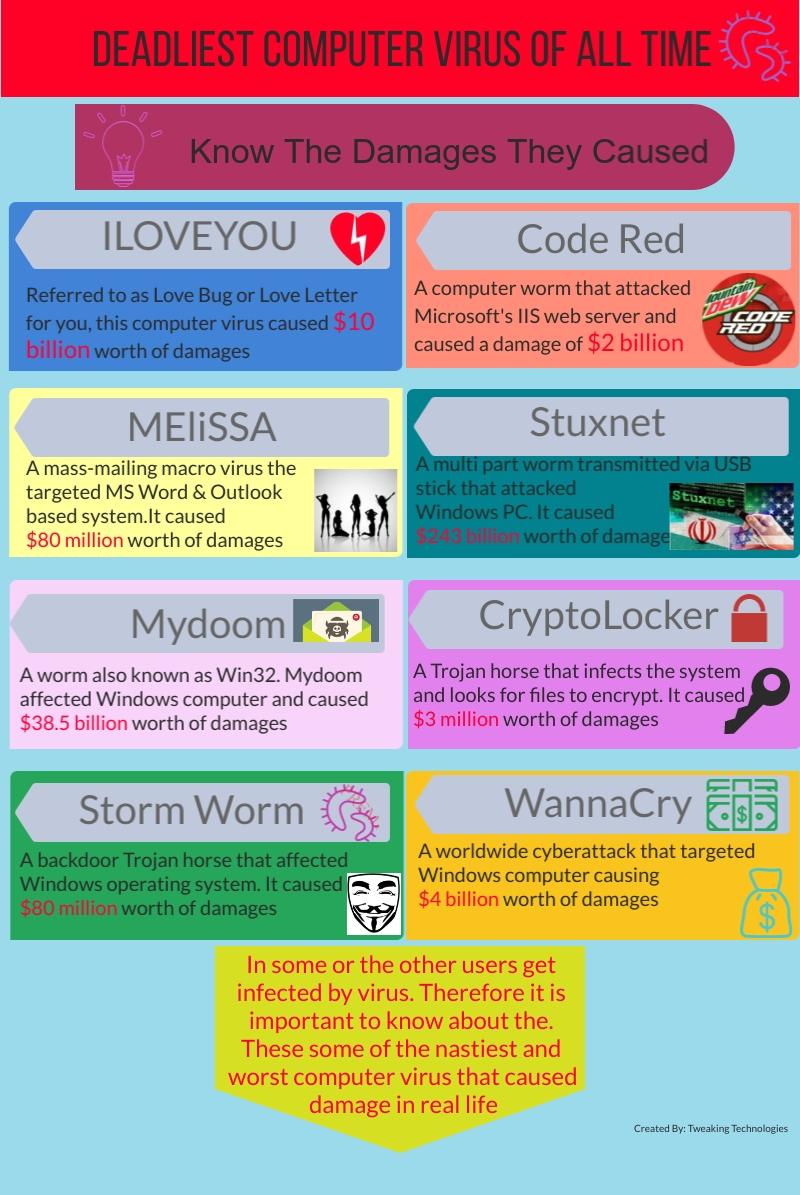No longer, cyber threats are limited to just PC. If you go online through any device, you are prone to cyber threats and data theft. Malware and phishing attacks, email scams, and ransomware attacks are becoming a big issue. They are also progressing with technological advancements, and cyber criminals are adopting new ways to infect devices and steal data.
Every year, more than 30 billion dangerous and deadliest computer viruses are blocked, and a new malicious computer virus emerges daily. Therefore, use the best preventative methods to protect your data and devices. Using an antivirus for your computer will help secure data and keep privacy intact.
This blog enlists the latest computer virus and explains the measures as to how to keep yourself safe from them.
|
Did You Know? Computer Viruses Cost U.S. Businesses Over $109 Billion A Year! |
Preventive Measures to Stay Secure From A Computer Virus Attack!
The obvious answer to this is we should use an updated and best anti-virus capable of detecting the latest computer virus. In addition to this, using a data recovery wizard tool like EaseUS is also recommended. This tool helps recover files deleted by the computer virus, an example of which was seen during the WannaCary attack. People who were using EaseUS were able to recover files even when their system was attacked. Hence we recommend using it along with using the best anti-malware software.
Download EaseUS Data Recovery Wizard Here
Read Also: Low Storage on Mac? Here are The 10 Best Mac Cleaners
Top 18 Latest & Malicious Computer Virus You Should Be Aware Of This Year
We are in the second quarter of 2022 and have witnessed several dangerous computer viruses of all time. Here we are sharing about how multiple kinds of malware are evolving in 2022.
List of Contents
- 1. RaaS
- 2. Cryptojacking
- 3. Artificial Intelligence (AI) Attacks
- 4. Mindware
- 5. Black Basta
- 6. Onyx
- 7. News Malware
- 8. PseudoManuscrypt Malware – The Nasty Malware of 2021
- 9. News Malware Alerts (Fake Coronavirus Mails)
- 10. Clop Ransomware
- 11. Social Engineering & Cryptocurrency
- 12. Artificial Intelligence the New Beneficiary for Hackers
- 13. IoT Malware Attacks
- 14. CDPwn (Added in February 2022)
- 15. Zeus Gameover
- 16. Cryptojacking
- 17. Rise of Cyborg Ransomware
- 18. Fleeceware
- More Tips To Keep Your Computer Safe From Computer Virus-
- Top 3 Recommended Antivirus Solutions
- 7 Deadliest Computer Viruses of All Time
- Frequently Asked Questions-
1. RaaS
“RaaS” — or “Ransomware as a Service” is a rapidly growing industry in the dark work of hackers. People who want to carry out a ransomware attack but are not skilled can hire a professional team. This is worrying as the RaaS industry is making it easy for people to infect other people’s devices. Despite not having any experience creating ransomware, they can rent someone to develop it. Some of the most dangerous computer viruses designed recently are done through RaaS. This industry is fast growing as without having to learn how to code once can wreak havoc and can enter into the world of cybercrime. One such example is the DarkSide, the attacks aimed at everyone, regardless of the operating system or the network type.
2. Cryptojacking
Though the crypto market has been shaky lately, crypto-jacking malware is making its way to mine cryptos using a person’s computing power. As mining requires a huge amount of computing power to generate new crypto coins, threat actors install crypto-jacking malware on computers and mobile devices to use the device power to mine cryptos. As cryptocurrency prices rise, a sudden spurt in crypto-jacking malware attacks is noticed, as it is a lucrative way for cybercriminals to earn money.
3. Artificial Intelligence (AI) Attacks
As ChatGPTm, Google Bard, Bing, and other AI programs are making a noise that they can simplify things, hackers are using them to carry out cyberattacks. To combat these attacks, cybersecurity companies are using AI and ML. Still, hackers are again using them for their benefit and exploiting them to hack devices and networks on a massive scale.
With the expansion of AI and machine learning, the cost of cyberattacks has decreased, and the development of highly-advanced and destructive AI-based malware is grown in last year and in 2024 as well.
4. Mindware
This malware came to light in March after it performed the double extortion attack. The malware comes with a new intrusion technique it steals data before it is encrypted.
5. Black Basta
In April 2022, after 11 dangerous cyber attacks, Black Basta made its way to the malware world. Like Mindware, it is an old actor but recently modified to cause severe damage.
6. Onyx
This latest and most dangerous computer virus wipes out files of particular sizes instead of encrypting files. Also, the hackers warn victims that their files will be leaked without the ransom.
7. News Malware
This might sound funny, but it isn’t. Hackers know how much people like to be updated, and for that, they read the news. Hence, they are now using trending news to target individuals. The hackers send readers a malicious link that looks like a trending news update, but in reality, it is malware designed to steal necessary information. The virus spreads and steals user data when the reader clicks on the link.
8. PseudoManuscrypt Malware – The Nasty Malware of 2021
Spotted by Kaspersky in January 2021, PseudoManyscrypt is a botnet distributed via fake software installers and application cracks promoted on different online sites. The pirated installers are mostly ICS-specific pirated software, various other malware strains. Not only this, but PseudoManuscrypt is also installed via the infamous Glupteba botnet, known for stealing user credentials, and cookies, mining cryptocurrencies on infected hosts, deploying and operating proxy components, and more. It infected around 3500 systems in 195 countries, most of which belonged to Russia (10.1%), India (10%), and Brazil (9.3%).
Other lures used to distribute the malware besides ICS include cracked or pirated versions of Call of Duty, Windows 10, Microsoft Office, Adobe tools, and even Kaspersky’s antivirus.
Once installed, PseudoManuscrypt allows attackers to control the infected system completely. This includes disabling antivirus, recording keystrokes, capturing screenshots, stealing VPN data, extracting data from clipboards, and more. One hundred versions of PseudoManuscrypt loader have already been identified, and to transfer data to command-and-control (C2) servers, it uses code in Chinese.
Currently, hackers are taking advantage of news stories & global events to target individuals with phishing attacks & spread malware. For instance: Cybercriminals are sending emails that claim to be sent out by the official WHO and give tips to the users to stay protected from the endemic Coronavirus.
Users who trust these emails fall prey to these tactics. Therefore, if you receive any emails in the name of WHO, a vaccine for coronavirus, or any tips that will help cure COVID-19, then never trust such emails. They are sent to inject Emotet malware into your device.
10. Clop Ransomware
Belonging to a popular Cryptomix Ransomware family, Clop is improving with time and causing major damage than ever before. There are tons of variants of Clop and their main goal is to encrypt all files in an enterprise and request huge ransom amounts to decrypt the infected files. Clop Ransomware mostly targets Windows users.
For instance: A dangerous file-encrypting virus that holds the potential to actively prevent the security of the system by encrypting the saved files by planting the .CLOP extension file. When this enters into your computer, it exploits AES Cipher to encrypt your data. For example: picture.jpg is renamed to picture.jpg.clop.
Attacks that use social engineering tactics are designed to especially target human aspects. For instance: A new Android banking trojan dubbed Gustuff is gaining popularity. The malicious computer virus targets cryptocurrency apps and known banks like Bank of America, Bank of Scotland, etc.
Not only this, but Sim swapping attacks are also skyrocketing this 2022. Due to clever social engineering, bad actors gain access to the SIM card of the victim and trick the mobile carrier into thinking it is the real customer that is using the device. Once hackers gain access, they use the victim’s social media accounts & cryptocurrency wallets for their good.
12. Artificial Intelligence the New Beneficiary for Hackers
With the increase in the number of AI devices, hackers are also being inclined toward it. They use it to develop the latest computer viruses and inject them into the victim’s computer without their notice. For instance: The malicious computer virus is smart enough to figure out its way to target your devices. AI-enabled attacks have the potential to bypass almost all kinds of authentication methods and remain undetected.
With time hackers are becoming technologically advanced. Therefore, you must maintain good digital hygiene to stay protected from a virus. And organizations should start operating with AI-enabled defenses to counter AI-enabled attacks.
13. IoT Malware Attacks
In recent years, IoT has gained popularity for its ease of use, but at the same time, it is surrounded by controversies for its lack of built-in firewalls. Most IoT devices fail to provide options to change the default username, thereby making devices an easy target for hackers. For instance: Lately, over 75% of healthcare entities are impacted by a host of TCP/IP vulnerabilities and associated threats against IT, OT, IoT & IoMT devices. A successful execution led to remote code execution, allowing bad actors to take complete access to devices.
Due to this 217.5% increase has been noticed in attacks targeting IoT devices. Therefore, if you have any plans to invest in an IoT device, we suggest looking for safety measures. Almost common security threats for IoT devices involve hijacking, leaks, home intrusions, etc.
14. CDPwn (Added in February 2022)
Security Threats for Tens of Millions of Network Devices
Don’t Ignore this, five high-rated Cisco vulnerabilities labeled as CDPwn. When exploited by the attacker, these four remote codes and one denial service will allow threat actors to take full control over all the Cisco devices.
For instance: These vulnerabilities are named as CVE-2020-3119 is a stack overflow vulnerability, CVE-2020-3118 is a format string vulnerability, CVE-2020-3111 is a stack overflow vulnerability in the parsing function, CVE-2020-3110 is a heap overflow vulnerability in the Cisco 8000 8000 series IP camera, and CVE-2020-3120 the denial-of-service vulnerability.
15. Zeus Gameover
Gameover is the latest computer virus in the Zeus Family. The malicious threat targets your device in a way to effortlessly access your bank account details and steals all your money.
For instance: Zeus Gameover is one of the deadliest computer viruses that certainly does not need a centralized ‘Command & Control server to inject malicious content, gain access, or transfer funds, similar to other common security threats. It simply creates its standalone server and accesses sensitive and confidential details of victims.
16. Cryptojacking
With a significant increase in the value of cryptocurrencies over the past couple of years, it won’t be completely wrong to say that 2022 is on the path to be the year of crypto-jacking. Since the emerging security threat mostly remains chronically unreported, it’s cumbersome to tell exactly the targeting measures used to exploit the victim’s device.
For instance: Cryptojacking software is planted in the user’s device to perform data exfiltration, credit card skimming, keylogging, and more.
17. Rise of Cyborg Ransomware
PC Cyborg, also known as (AIDS) Aids Info Disk Trojan, is the first-ever ransomware introduced through a floppy disk. This is why it is called AIDS. This trojan horse virus replaces AUTOEXEC.BAT used to count the number of times a computer is booted. documented. In 2020, a ransomware variant known as Cyborg was found in a fake Windows 10 November update.
For instance: Bad actors deploy a mix of bots and fraud farms to successfully pull off cyborg attacks. There has been a 36% increase in these types of attacks from Q4 2020 to Q1 2021.
18. Fleeceware
This is another major security threat you should be aware of. It’s a scam in sheep’s clothing, where sneaky developers charge hefty amounts for basic applications. Over 600 million Android users recently downloaded “Fleeceware” onto their devices and were duped. Unlike other malware, Fleeceware doesn’t pose a considerable security threat to a user’s device and data. However, developers use this shady practice to cash in on unsuspecting users. They don’t steal any of your data or try to gain access to your device.
Rather, Fleeceware hinges on apps that are advertised with a free trial period but instead come with hidden subscription fees. For example, an alarm clock app costs $12 per week, or a photo editing app that’s $30 per month, would be fleeceware. They even charge you after the app is uninstalled!
More Tips To Keep Your Computer Safe From Computer Virus-
- Install good antivirus software on your computer.
- Use a firewall (It is inbuilt in Windows 10 and 8).
- Update software regularly.
- Avoid opening suspicious web pages.
- Don’t respond to spam mail.
- Avoid clicking on suspicious links or attachments.
- Don’t attach new external drives to your computer.
- Choose strong passwords and never share it with anyone.
- Don’t download pirated material.
- Always browse protected web browsers.
- Change your privacy settings for all online accounts.
- Make sure your computer has a login account.
- Keep operating systems updated.
- Take a backup of your important data.
- Use safe data sharing networks.
- Scan mail attachments before download.
- Keep different passwords for all accounts.
- Download from the authenticated/ official websites/web links.
- Use cloud backup for saving data.
Top 3 Recommended Antivirus Solutions
You can rely on any of these below-mentioned security solutions to get advanced protection against the latest computer viruses & other malware threats.
7 Deadliest Computer Viruses of All Time

- ILOVEYOU – A well-known and worst computer virus (worm) that emerged in 2000 was spread via an email with a subject I love You.
- Cryptolocker – A notorious malware that became popular over the years. This trojan horse infects your computer and encrypts files.
- Melissa – Released on March 26th, 1999, this mass-mailing macro virus was classified as a worm. This deadliest computer virus targeted MS Word and Outlook based systems.
- Mydoom – Another damaging cyber threat affected the Windows-based systems. This malicious threat was spread via phishing.
- Stuxnet – A multi-part worm and most dangerous virus that traveled via USB.
- Storm Worm – Discovered on January 17, 2007, this backdoor Trojan horse affects Windows and caused huge damages.
- CodeRed – Seen on the Internet on July 15, 2001, this cyber threat attacked Microsoft’s IIS web server.
So, these are some of the most dangerous of all the computer viruses. Attackers design them to steal confidential data hence it is important to know how to deal with these everyday latest computer viruses, cyber threat landscape, trojan horses, worms, and malware.
Now, that we know about popular computer viruses. It’s time we talk about the latest computer viruses that have evolved recently and how to stay protected from these malicious computer viruses.
Frequently Asked Questions-
What is the most dangerous computer virus right now?
With pandemic challenging our lifestyles and an increase in our dependence on the digital world, vulnerability to malware.pixa Numerous malicious organizations are taking advantage of it and starting cyber threats in the name of updated information on the COVID-19.
What are the worst computer viruses?
ILOVEYOU is a 20-year-old virus that has infected millions of computers by now. It started as a spam mail, and since then, it has spread all over the world. This virus turned out to be one of the worst computer viruses, and it is making rounds once again.
What is the best antivirus program?
While selecting the best antivirus program for your computer, make sure it provides all safety measures. The best antivirus software must have an updated database to detect the latest computer virus. It should be able to scan the system thoroughly regularly.
What is the latest computer virus going around?
The latest computer virus to watch for is Fake Windows update and WinRAR malware. This is quite common as the Windows users look for updates or WinRAR regularly.
Conclusion:
So, this was all folks! The above list is not the end of the latest and most dangerous computer viruses. With each passing day they will evolve with more severity. Therefore, it is important that you follow all the necessary web practices and preventions to stay safe and secure.
And in case you find some loophole, make sure you report it to your service provider as soon as possible.
We will keep updating this post to keep you aware of the deadliest computer viruses and how smart attackers are becoming in designing these cyber threats. So stay connected and keep reading the post from time to time.
Read More: Remove Viruses with Best Antimalware Tools
If you found this helpful, please let us know. You can also drop your feedback in the comment section below.
Recommended Readings:
Tips To Create Secure Passwords To Protect Your Account
Do I Need an Antivirus Program for My Mac?
Scarab Ransomware Targets E-mail Accounts
Best Tips to Stay Protected Online












saakshi
thanku